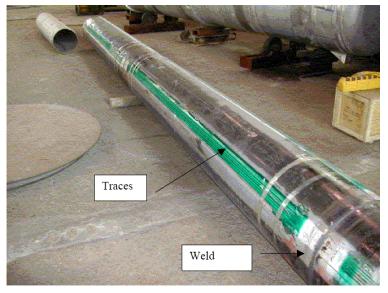- Characterized variability in trace electrical resistance on flat plates to determine sensitivity to strain levels,
- Developed computer code for logging strain and resistance data, and
- Successfully demonstrated that detection and location of pipeline damage is possible using a system of resistive traces on a 50-foot pipe section.
The Idaho National Engineering & Environmental Laboratory has developed an approach to real time pipeline monitoring that utilizes porous metal resistive traces to detect damage by measuring the strain state of the pipeline. The technique would involve a network of such traces deposited on either the interior or exterior wall of a pipeline. The ability of a resistive trace to detect damage is based on the unique manner in which a porous metal changes resistivity when placed under strain. While a bulk metal conductor (e.g., wire) maintains a constant resistivity when strained, unless a change in length occurs, a porous metal conductor shows a significant change in resistance when plastically deformed, regardless of any change in length. This characteristic could enable a network of such traces to be used to identify and locate points along a pipeline where deformation, and possible damage, has occurred.
A resistive trace is created using a thermal spray process. Fine metallic powders or wire are deposited in a molten condition on a substrate (metallic or nonmetallic) by passing the material through a heat source and gas flow stream. The thickness, width, segment length, porosity, number of layers and material composition can be varied to control the conductivity. If the mechanical properties of the trace are changed due to outside forces, the resulting conductivity changes can be measured. Micro-instrumentation embedded into or adjacent to conductive traces could be used to transmit specific measurements or data.
For this project, resistive traces were produced by thermally spraying nickel aluminide alloy on to 0.125-inch steel coupons. The resistivity of the traces was measured while the coupons were subjected to four-point bending and the change in resistance recorded. The results revealed that traces with different baseline resistivity values would exhibit a similar percentage change in resistance in response to strain. Also, the traces did not show any sensitivity to strain until the level approached plastic deformation. The magnitude of trace resistivity change as a function of strain has been found sufficient to allow detection and location of damage along a nominal 20-mile section of pipeline with a location resolution of 40-80 ft.
In August 2003 a test was carried out to demonstrate how the resistance change from the network of traces could be detected and used to locate a segment of pipe undergoing strain. Five, 10-foot segments of pipe were outfitted with a set of five parallel resistive traces applied to each pipe quadrant and connected across the welds via wires from solder pads at the end of each pipe segment. A four-point bending device was designed so that a selected segment of the pipe could be placed into bending without placing significant stress on the other four segments of the pipe.
The system successfully detected low levels of strain, although the data collection software program failed to collect all of the data. However, unlike the flat plate tests, the change in resistance of different trace values was found to be nonlinear. This factor would affect how the system would be used to locate the pipe segment under strain in an actual pipeline. Because the change in resistance of each class of data trace has a different curve, the data trace with the highest resistance/ft value would react first to an increasing strain level. The data trace with the next highest resistance value reacts slightly later in time with a steeper curve to increasing strain. Evidence of this relationship had not been seen in flat plate tests done previously in the project.
Detection of strain on the pipe was immediate and consistent for pipe in both the elastic deformation and the plastic deformation phases. Signal response from the high resistance traces occurred at much lower levels of strain than was expected.




